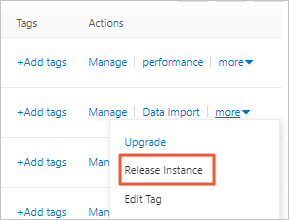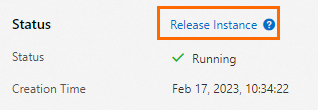If you no longer need an ApsaraDB RDS for MySQL instance, you can manually release a pay-as-you-go or serverless RDS instance or subscribe from a subscription RDS instance. This topic describes the methods, usage notes, and FAQ for releasing and unsubscribing from an RDS instance in the ApsaraDB RDS console or by calling API operations.
Usage notes
You can release pay-as-you-go or serverless RDS instances or unsubscribe from subscription RDS instances. After you release or unsubscribe from your RDS instance, the data of the RDS instance is retained for a period of time in the following situations:
The following RDS instances are moved to the recycle bin. You can unlock and rebuild the RDS instances in the recycle bin.
Unsubscribed or expired subscription RDS instances
Released pay-as-you-go RDS instances
Released serverless RDS instances
NoteRDS instances that meet specific requirements are moved to the recycle bin. For more information, see Manage ApsaraDB RDS for MySQL instances in the recycle bin.
If the cross-region backup feature is enabled for the RDS instance and the specified retention period does not elapse, the backup files that are generated by using the cross-region backup feature are retained. For more information, see Use the cross-region backup feature.
If the Backup Retention Policy After Release parameter is configured for the RDS instance, the backup files of the RDS instance are retained even if you release or unsubscribe from the RDS instance. You can download the backup files to your computer. For more information, see Method 2: Configure the backup retention policy after the instance is released.
WarningIn other situations, the data of an RDS instance is immediately deleted after you release or unsubscribe from the RDS instance. The data cannot be restored. Proceed with caution. Before you release or unsubscribe from an RDS instance, we recommend that you back up the RDS instance and download the backup files. For more information, see Enable the automatic backup feature and Download the backup files of an ApsaraDB RDS for MySQL instance.
If you want to release or unsubscribe from the last read-only RDS instance of a primary RDS instance, you must disable the read/write splitting feature for the primary RDS instance. For more information, see Disable read/write splitting for an ApsaraDB RDS for MySQL instance.
After you release or unsubscribe from a primary RDS instance, the subscription read-only RDS instances or pay-as-you-go read-only RDS instances of the primary RDS instance are automatically deleted. In addition, the payments for the subscription read-only RDS instances of the primary RDS instance are refunded.
After your RDS instance is released, the RDS instance is no longer displayed in the ApsaraDB RDS console, and no fees are generated. If your RDS instance is moved to the recycle bin after you release or unsubscribe from the instance, you can rebuild the instance from the recycle bin. For more information, see Manage ApsaraDB RDS for MySQL instances in the recycle bin.
Release a primary RDS instance
Release a pay-as-you-go primary RDS instance and a serverless RDS instance
Log on to the ApsaraDB RDS console. In the left-side navigation pane, click Instances. In the top navigation bar, select the region in which the primary RDS instance resides.
Use one of the following methods to release an RDS instance:
Find the required RDS instance and choose in the Actions column.

Find the RDS instance and click the ID of the instance. In the Status section of the Basic Information page, click Release Instance.
In the message that appears, click OK.
Unsubscribe from a subscription primary RDS instance
You can use one of the following methods to unsubscribe from a subscription RDS instance:
Unsubscribe page
If you want to unsubscribe from a subscription RDS instance, submit a ticket.
Basic Information page
Log on to the ApsaraDB RDS console. In the left-side navigation pane, click Instances. In the top navigation bar, select the region in which the RDS instance resides.
Click the instance name. In the Status section of the Basic Information page, click Cancellation of Instance Subscription to go to the Unsubscribe page.
Instances page
Log on to the ApsaraDB RDS console. In the left-side navigation pane, click Instances. In the top navigation bar, select the region in which the RDS instance resides.
In the Actions column of the RDS instance, choose More > Cancellation of Instance Subscription. In the dialogue box that appears, click OK to go to the Unsubscribe page.
Release a read-only RDS instance
Release a pay-as-you-go read-only RDS instance
- Log on to the ApsaraDB RDS console. In the left-side navigation pane, click Instances. In the top navigation bar, select the region in which your RDS instance resides.
Use one of the following methods to release an RDS instance:
Find the RDS instance and choose in the Actions column.

Find the RDS instance and click the ID of the instance. On the Basic Information page, click Release Instance.

In the dialog box that appears, click OK.
Unsubscribe from a subscription read-only RDS instance
You can use one of the following methods to unsubscribe from a subscription RDS instance:
Unsubscribe page
If you want to unsubscribe from a subscription RDS instance, submit a ticket.
Basic Information page
Log on to the ApsaraDB RDS console. In the left-side navigation pane, click Instances. In the top navigation bar, select the region in which the RDS instance resides.
Click the instance name. In the Status section of the Basic Information page, click Cancellation of Instance Subscription to go to the Unsubscribe page.
Instances page
Log on to the ApsaraDB RDS console. In the left-side navigation pane, click Instances. In the top navigation bar, select the region in which the RDS instance resides.
In the Actions column of the RDS instance, choose More > Cancellation of Instance Subscription. In the dialogue box that appears, click OK to go to the Unsubscribe page.
Automatically release a read-only RDS instance
After you release or unsubscribe from a primary RDS instance, the subscription read-only RDS instances or pay-as-you-go read-only RDS instances of the primary RDS instance are automatically deleted. In addition, the payments for the subscription read-only RDS instances of the primary RDS instance are refunded.
FAQ
If I release or unsubscribe from a read-only RDS instance, are my workloads interrupted?
Yes, if you release or unsubscribe from a read-only RDS instance, your workloads on the read-only RDS instance are interrupted.
If you enable the database proxy feature for your RDS instance, we recommend that you set the read weight of a read-only RDS instance to 0 before you release or unsubscribe from the read-only RDS instance. For more information, see Modify the latency threshold and read weights of ApsaraDB RDS for MySQL instances.
NoteThe cached connection to the read-only RDS instance remains valid. If you want to forward the read requests over the cached connection to other read-only RDS instances, you must establish new connections.
If you do not enable the database proxy feature for your RDS instance, you must modify the application code to replace the connection settings for the read-only RDS instance that you want to release or unsubscribe from with those of another read-only RDS instance or the primary RDS instance.
After I release or unsubscribe from my RDS instance, how do I retrieve the data of the RDS instance?
If your RDS instance is configured to retain backup files after you release or unsubscribe from your RDS instance, you can go to the Backup for Deleted Instances tab of the Backups page in the ApsaraDB RDS console to restore the data of your RDS instance. For more information, see Enable the automatic backup feature.
I cannot find Release Instance in the ApsaraDB RDS console. Why?
You can only unsubscribe from subscription RDS instances.
Related operations
Operation | Description |
Releases a pay-as-you-go or serverless RDS instance. You cannot unsubscribe from a subscription RDS instance by calling the API operation. |